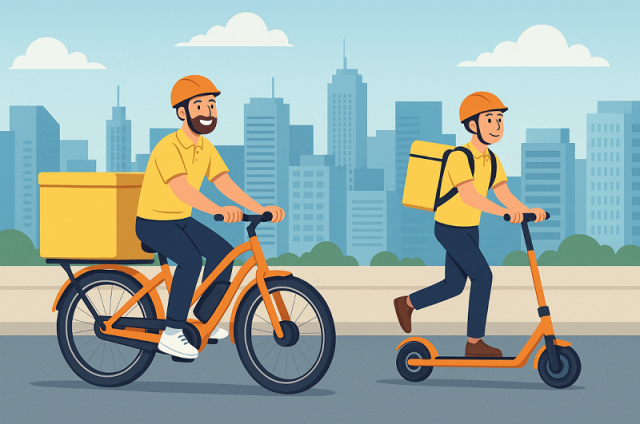Beyond the Gridlock: Reimagining the Final Mile
E‑commerce changed everything, but the last mile—the final stretch from the local depot to your doorstep—remains stubbornly inefficient. This stage accounts for a large share of delivery costs and emissions, while vans congest roads and burn fuel. Without intervention, experts predict that delivery vehicles could increase by a third in major cities over the next decade, exacerbating congestion and air pollution. To meet soaring demand while avoiding gridlock and rising emissions, planners and parcel carriers are turning to micromobility solutions: small electric cargo bikes and scooters designed for rapid, clean deliveries.
Pedal Power Reimagined: The Rise of Cargo Bikes
Electric cargo bikes lead this transformation. These robust machines resemble minivans on two or three wheels, with long wheelbases, large boxes, and electric motors that make hauling heavy loads easy. They carry loads up to 330 pounds (about 150 kilograms) and navigate bike lanes and alleys that are off‑limits to vans, parking directly at the customer's door. By eliminating the time spent stuck in traffic or searching for parking, bikes complete routes faster. Pilot programs show bikes outperform vans on short routes and can double daily deliveries while cutting emissions. Logistics giants like UPS and DHL have embraced cargo bikes because they cut fuel and maintenance costs while meeting sustainability targets.
Scooters and the Art of the Quick Drop
Electric scooters handle ultra‑short deliveries. Couriers on scooters weave through crowded streets and bring meals or small parcels straight to an elevator lobby. Although scooters carry less than cargo bikes, they deliver with unmatched agility. In hub‑and‑spoke systems, bikes or small vans transport batches of parcels to micro‑depots dotted around the city; scooter riders then take individual packages the final few blocks. This layered approach ensures speed and flexibility across diverse urban landscapes.
Cutting Carbon and Clearing the Air
The environmental benefits of micromobility are striking. Conventional vans run on diesel and contribute to greenhouse gas emissions, smog, and noise. Electric cargo bikes and scooters produce no tailpipe pollution and use far less energy per mile, especially on short routes. Replacing just a portion of van trips with bikes reduces carbon emissions, shrinks the fleet's carbon footprint and lessens traffic congestion. Because they occupy less space and avoid idling, these vehicles ease pressure on roads, lower noise and create healthier streets. Cleaner air and quieter neighborhoods improve quality of life while helping cities meet climate goals.
Economics of the Tiny Vehicle Revolution
Lower costs are another advantage. The last mile is expensive because every stop involves labor, vehicle wear and fuel. Electric cargo bikes cost less to purchase and maintain than vans, require minimal insurance, and face no road taxes in many countries. Riders avoid congestion charges, tolls and parking fines, and they make more stops per hour because they don't need to search for spaces. Companies can increase capacity with small trailers or by positioning bikes at micro‑depots closer to customers. When dispatchers coordinate multiple bikes and scooters using route‑optimization software, total distances traveled drop and the number of packages delivered per hour rises, improving profitability and customer satisfaction.
Technology for Transparency and Trust
Technology is the glue that holds micromobility networks together. Dispatchers rely on software to assign orders, plan routes and track vehicles in real-time, rerouting riders around accidents or congestion. Customers expect transparency: they want to know when their parcels will arrive and where they are now. A seamless package tracking dashboard at https://trackingpackage.com lets shoppers enter a tracking number and see where a package is, which carrier is handling it and when it is likely to arrive. This platform integrates data from multiple carriers and micromobility fleets, pushing updates to customers' phones. By offering clear, reliable information, companies build trust and reduce the flood of “where is my package?” inquiries. In crowded cities, this visibility also reduces the anxiety associated with waiting for a delivery and supports the sense of trust between sender and recipient.
A New Urban Rhythm
Micromobility is a practical response to the challenges of urban logistics. Electric cargo bikes and scooters prove that small vehicles can move goods quickly, cheaply and cleanly. Early pilots show that they can handle a significant share of urban deliveries, reduce emissions and cut costs. Combined with micro‑depots, sophisticated routing software and user‑friendly tracking tools, micromobility offers a blueprint for a sustainable last mile. As e‑commerce continues to grow and cities tighten emissions regulations, expect to see more couriers pedaling and scooting their way to your front door, creating a future where deliveries blend seamlessly into city life and streets breathe a little easier.






